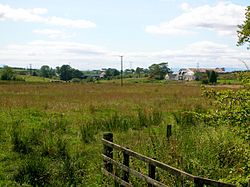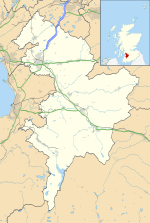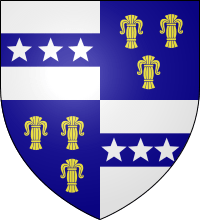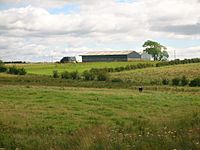Polkelly Castle facts for kids
Quick facts for kids Polkelly Castle |
|
|---|---|
| Fenwick, East Ayrshire, Scotland UK |
|

Pokelly Hall and Balgray Mill
|
|
| Coordinates | 55°40′34″N 4°27′21″W / 55.676102°N 4.455712°W |
| Site information | |
| Owner | Private |
| Controlled by | Mure family |
| Open to the public |
No |
| Condition | Removed |
| Site history | |
| Built | 14th century |
| Built by | Mures |
| In use | Until 16th century |
| Materials | stone |
Polkelly Castle, also known as Pokelly, was an old castle in Scotland. It was located near Fenwick, north of Kilmarnock, in East Ayrshire. This castle was part of the medieval Barony of Polkelly. Over time, its name was spelled in many ways, like Powkelly, Pockelly, and Pokellie. Around 1564, it was known as Powkellie and belonged to the Cunninghams of Cunninghamhead.
Contents
Exploring Polkelly Castle's Past
The Land Around Polkelly
Before the 1390s, the land of Polkelly likely belonged to the Comyn family. This area was very important. It gave the lords of Rowallan easy access to the large grazing lands of Macharnock Moor, now called Glenouther Moor.
In 1512, official documents showed that the Polkelly area included several smaller lands. These included Darclavoch, Clonherb, Clunch, and Balgray. Balgray even had its own tower, manor, and mill.
Later, in the early 1500s, during the time of King James V, the Cochrane family owned Polkelly. Records also show that the Mure family once held a large part of Polkelly, about 2400 acres. Much of this land was used for farming.
Some historians believe that Polkelly and the nearby Rowallan area might have been connected since ancient times. This could go back to the Britonic period of the Kingdom of Strathclyde.
The Castle's Story
Polkelly Castle was once a significant place within the larger area of Rowallan. However, its importance lessened around 1512. At that time, Balgray became the main center for the Polkelly region.
The castle's remains were removed in the 1850s. The stones were used to build a road. Today, only a small mound, called a motte, is left. In 1590, a group of soldiers was sent to protect the "house and fortalice of Pokelly." This happened after some pirates caused trouble near Ailsa Craig.
Who Owned Polkelly Castle?
Around 1280, a document shows that Sir Gilchrist Mure received the lands of Pokelly. He even had to find shelter there once when there was trouble with Sir Walter Comyn. To bring peace, Sir Gilchrist married Sir Walter's daughter, Isabella.
In 1399, Sir Adam Mure owned the castle. After he passed away, it went to his second son. The eldest son received Rowallan Castle.
The Mure family mostly owned Polkelly Castle and its lands for a long time. However, by 1511, Robert Mure of Polkelly had died. His daughter, Margaret, became the sole heir. In 1512, Margaret married Robert Cunningham of Cunninghamhead. The Mure family's star symbols were then added to the Cunningham family's coat of arms.
After about 50 to 60 years, the Cunningham family sold Polkelly. It was bought by Thomas Cochran of Kilmaronock. Later, in 1699, it passed to his brother William. Eventually, David, the first Earl of Glasgow, acquired the property. James, Earl of Glasgow, owned it in the 1870s. In the 1860s, the castle ruins were described as the "strong house of Polkelly."
In the late 1400s, a Mure from Polkelly worked for the king. He helped collect royal rents in central Scotland.
Early Religious Ideas
Helen Chalmers, who was married to Robert Mure of Pokellie, was known as a supporter of the Lollards. These were people who wanted to see changes in religious practices in Ayrshire during that time.
The Glenouther Moor and Its Importance
The large area of common grazing land north of Polkelly was called Machirnock or Maucharnock Moor. Today, it is known as Glenouther Moor. This land was very valuable. The Cunningham and Mure families sometimes had disagreements over who could use it for grazing their animals.
In 1534, a royal letter helped settle a dispute. It decided how many animals each family could keep on the moor. This was called "souming." Later, in 1594, William Mure of Rowallan complained that Polkelly's cattle and geese were grazing too much on the moor.
Historians believe that the Macharnock River gave its name to the Kilmarnock Water. This area was also the site of an old battle between the Douglas and De Mowbray families.
Polkelly on Old Maps
Old maps help us understand what Polkelly Castle and its surroundings looked like. A map from the early 1600s, based on Timothy Pont's survey, shows a tower at Polkelly. It does not show any surrounding woods.
Later, Armstrong's map from 1775 shows two buildings called Pockelly. However, neither of them looked like a castle or a large house. The name Pokelly Hall first appeared on Thomson's Map in 1832. By 1890, an Ordnance Survey (OS) map showed Pokelly Castle inside a fenced area. It was near the Balgray Mill Burn and connected to a network of roads. Sometimes, old records called Pokelly Hall by the name Pathelly Hall.
Some of the smaller places mentioned in old documents still exist today. For example, Cleuche is now called Clunch on modern maps. The name Darclavoch, which might mean "land of stones," is now Dareloch. Drumboy was once known as Drumbuy.
King James V's Visit to Polkelly
There's a famous story about King James V visiting the area. An old cottage near Stewarton was called "King's Kitchenhead." The legend says that King James V, while traveling to make important decisions about justice, stayed at this cottage.
The wife of the house recognized the King. She bravely asked him to spare her husband, who was facing judgment. The King agreed and told her husband to "be a better bairn" (a better person). Some versions of the story say that other people were also at Polkelly Castle. The King warned the husband that if he ever caused trouble again, no one would be able to help him.
There was a special tree at Polkelly, sometimes called a "dule tree." It was a place where important decisions were made. Records from the 1850s mention that this tree was cut down many years before.
The King's Well and Stables
Another story about King James V tells of his horse getting stuck in a muddy area near Kingswell. This happened after the horse drank from a place called the King's Well. This legend suggests that the King was on his way to Polkelly Castle to handle royal duties, not to a wedding at Sorn Castle. Today, a building stands where the King's Stable was once located.
People Connected to Polkelly
Over the centuries, many people lived in or were connected to Polkelly. In 1793, James Dunlop, who was associated with Polkelly, owned the land of Gardrum.
In the 1400s, Robert Craufurd of Craufurdland married Elizabeth Muir, whose father was the Laird of Pokelly. They had three sons. Later, after Hugh Muir of Pokelly passed away, Archibald Craufurd of Craufurdland married Hugh's widow. She was the eldest daughter of Archibald Boyd.
In the mid-1600s, Diana Cunninghame, the only daughter of Sir David Cunninghame, married Thomas Cochrane of Polkelly. Around this time, a large part of the Polkelly estate was sold.
Interestingly, a person named David Poe lived on a farm called Polkelly. This farm was near Fenwick and Stewarton. This David Poe, who lived in Ayrshire in 1666, is thought to be an ancestor of the famous writer Edgar Allan Poe.
It's also good to know that there is another place called Polkelly in South Lanarkshire, not far from Carstairs.





